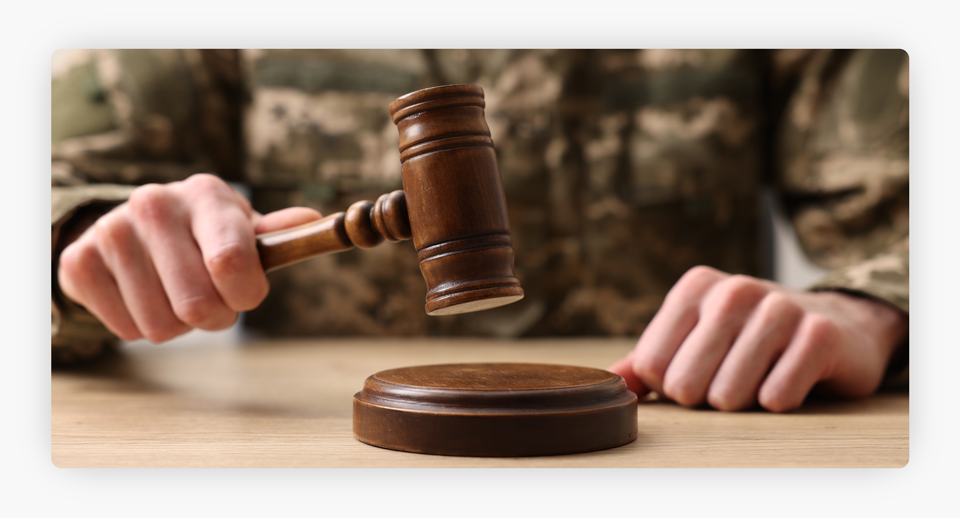We can’t send you updates from Justia Onward without your email.
Unsubscribe at any time.
Serving in the military can change your life, whether it’s your long-term career or just one stage of your journey. Nuanced rules apply to service members and veterans, who may not always know the full scope of their rights. That’s where the Military Law Center at Justia can help.
Americans who serve in the armed forces may encounter a host of distinctive legal issues both before and after their service. For example, a service member who violates the Uniform Code of Military Justice (UCMJ) may face a court-martial or a less formal disciplinary procedure. After leaving the armed forces, meanwhile, a veteran may be eligible for benefits in areas such as health care and education. They’re also entitled to certain rights involving civilian employment. The Military Law Center in the Justia Legal Guides discusses these topics and many others that may affect service members, veterans, and their loved ones. Here’s a look at some common questions to which this free resource provides basic answers.

What Is an Article 15?
An Article 15 is a type of non-judicial disciplinary procedure in the armed forces. It’s used for relatively minor violations of the Uniform Code of Military Justice. Penalties can be imposed if a violation is found by a preponderance of the evidence, which is less demanding than the “beyond a reasonable doubt” standard in a court-martial. A service member can usually decline an Article 15 and request a court-martial instead, but this can be risky because a court-martial might result in more severe penalties. Sometimes Article 15s eventually can be removed from a military record, although not always.
How Are Special and General Courts-Martial Different?
Special courts-martial address less serious allegations than those addressed by general courts-martial. This is similar to the difference between misdemeanors and felonies in civilian criminal prosecutions. As a result, a conviction in a general court-martial carries greater penalties. For an enlisted service member, a special court-martial may result in up to one year in prison and a bad conduct discharge, while a general court-martial may result in up to life in prison (or even the death penalty) and a dishonorable discharge. Special and general courts-martial shouldn’t be confused with a summary court-martial, which is a simpler procedure for very minor offenses.
How Do You Appeal a Court-Martial Decision?
You can appeal a conviction in a summary court-martial to the next higher level of command. Meanwhile, appeals of convictions in special and general courts-martial go to the military appeals courts. (Before an appeal gets to them, the “convening authority” who sent the case to a court-martial will review the decision.) There are four of these courts, serving the Army, the Navy and the Marines, the Air Force, and the Coast Guard. A service member who doesn’t win at this stage can ask the Court of Appeals for the Armed Forces for further review. In rare cases, they might eventually ask the U.S. Supreme Court to review the case.

What Is an Unfitness Finding?
An unfitness finding indicates that a service member has a physical or mental condition that prevents them from performing their regular duties. A service member who is found unfit will be placed on the permanent disability retirement list if they have served for 20 years, or if they have a stable condition with a disability rating of at least 30 percent. They’ll be placed on the temporary disability retirement list if their disability rating is at least 30 percent, but their condition is not stable. If a service member has not yet served for 20 years and has a lower disability rating, they may get separation with severance pay. Finally, separation without benefits may be ordered in certain cases, such as when the service member got injured while they were AWOL or caused their injury through their own misconduct.
How Do I Upgrade My Military Discharge?
You can ask for an upgrade from the Discharge Review Board or the Board of Correction for Military Records. The DRB handles most types of reviews, but upgrade requests based on a general court-martial discharge will need to go to the BCMR. The BCMR also can review appeals of DRB decisions. The DRB requires you to show that the discharge or the reason for it was improper or inequitable, while the BCMR requires proof of an error or injustice. There’s also a Discharge Appeal Review Board that reviews certain requests by people who left the armed forces after December 20, 2019.
Who Is Eligible for Veterans’ Benefits?
If you got an honorable discharge, you’ll be eligible for the full scope of veterans’ benefits. If you got a slightly lower level of discharge called a general discharge under honorable conditions, you’ll likely be able to get most types of benefits. A veteran with an other than honorable discharge often won’t be able to get veterans’ benefits, but the VA may find that the veteran is eligible after a review called a character of discharge determination. A veteran who got a bad conduct discharge from a special court-martial also can ask for this type of review. Meanwhile, a dishonorable discharge or a bad conduct discharge from a general court-martial almost always will prevent a veteran from getting benefits.

Can I Get My Job Back After Serving in the Military?
Yes, a federal law called the Uniformed Services Employment and Reemployment Rights Act allows you to return to the job that you held before joining the military (or a higher position that you would have reached if not for your service) if you meet certain requirements. These include serving for no more than five years and getting a non-disqualifying discharge, which usually means an honorable discharge or a general discharge under honorable conditions. You’re entitled to a job that’s essentially the same as your past job if it doesn’t exist anymore, or if reinstatement otherwise isn’t possible. USERRA also broadly protects veterans from discrimination based on their military service.
Can I Get Leave From Work When My Spouse Goes on Active Duty?
Urgent needs may arise when a service member goes on active duty. The federal Family and Medical Leave Act provides up to 12 weeks of unpaid, job-protected leave in a 12-month period to address some of these issues. (The 12 weeks are a total, however, so an employee who has taken FMLA leave for other reasons won’t have 12 weeks of this leave.) Some of the reasons for this qualifying exigency leave include attending military events, updating financial and legal arrangements, setting up child care, and arranging for care of the service member’s parent. Only certain employees qualify for FMLA leave, though. For example, they generally need to work at a place where the employer has 50 employees within 75 miles, and they must have at least 1,250 hours of service within the last 12 months.
What Are Veterans Treatment Courts?
Various counties and some states have established veterans treatment courts to address crimes committed by former service members. These courts prioritize treatment and rehabilitation, so a veteran might not face penalties as severe as those faced by an ordinary defendant in the same situation. For example, a veteran sometimes might be able to get a charge dropped if they complete a court-ordered treatment program. Certain types of charges can’t be handled through veterans treatment courts, though, often including various sex crimes and violent crimes.
Final Thoughts
A military disciplinary proceeding or a dispute over veterans’ benefits can leave a lasting impact. The laws and regulations in this area aren’t easy to navigate on your own. If you have a significant legal concern involving your service in the armed forces, it’s best to consult a military lawyer about how you might handle it. They can evaluate your situation, explain your options, and potentially represent you if needed. In the meantime, the Military Law Center offers a readable overview of some key concepts to know. Like the other Justia Legal Guides, it furthers our mission of making the law free and accessible to all.
Related Posts